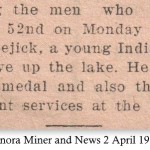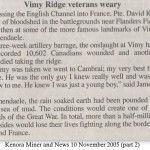

| Personal Details | |
| Date of Birth | June 20, 1896 |
| Place of Birth | Shoal Lake, Ontario |
| Country | Canada |
| Marital Status | Single |
| Next of Kin | Mrs. Bena Kisek (mother), Shoal Lake, Ontario |
| Trade / Calling | Trapper |
| Religion | Aboriginal |
| Service Details | |
| Regimental Number | 821017 |
| Service Record | Link to Service Record |
| Battalion | 52nd Battalion |
| Force | Canadian Expeditionary Force |
| Branch | Canadian Infantry |
| Enlisted / Conscripted | Enlisted |
| Address at Enlistment | Kenora, Ontario |
| Date of Enlistment | September 26, 1916 |
| Age at Enlistment | 20 |
| Theatre of Service | Europe |
| Prisoner of War | No |
| Survived War | Yes |
| Decorations and Medals | Distinguished Conduct Medal |
| Death Details | |
| Date of Death | March 1, 1969 |
| Buried At | Shoal Lake, Ontario |
Kejick, David
Private David Kejick was 20 years old when he enlisted in Kenora, Ontario in the fall of 1916. He served in Canada, England, France and Belgium for over two years and earned a Distinguished Conduct Medal in the last weeks of the war.
The war started in August 1914 and by 1916 more volunteers were needed to replace Canadian casualties at the front. David was living in the Kenora area at the time, working as a trapper, and he enlisted on 26 September 1916 with the 141st Bull Moose Battalion. Several of his friends had joined the same unit earlier that summer. Davie was a big lad, 6’1″ and 180 lb. with a 40″ expanded chest. According to his attestation he was born on 20 June 1896 at Shoal Lake, a First Nations community about 25 km west of Kenora. His widowed mother, Mrs. Bena Kisek (Kejick) of Shoal Lake, was named as his next of kin.
The 141st Battalion had been mobilized in December 1915 and it was recruited in northwestern Ontario. The unit was based in Port Arthur and the Kenora volunteers were sent there in August 1916. David, along with others who signed up later, joined the battalion in Port Arthur that fall and the men trained there over the winter. In the spring David contracted the measles and he spent two weeks recovering in the barracks hospital. He was discharged on 30 March and three weeks later the battalion left for Halifax on the first leg of their journey overseas. They embarked for the UK on 28 April on the SS Olympic and in England the men were absorbed into the 18th Reserve Battalion to be used as reinforcements for other units.
David trained in England for another five months. In August 1917 he had a short stay in the hospital at Shorncliffe Camp, getting treated for a skin condition, and on 27 September he was drafted to the 52nd Battalion and sent to France. The 52nd was a front line unit that had been raised in towns throughout northwestern Ontario, including Kenora. After some time at the Canadian Corps Base Depot David joined his new unit in the field in early November, during the Battle of Passchendaele. The battalion had suffered heavy losses in late October and David arrived in a draft of reinforcements. A week later, after the capture of Passchendaele Ridge, the 52nd had a rotation in the front trenches and they suffered more casualties when the Germans shelled their position.
Following the battle the Canadian Corps left the Ypres Salient and moved back south to the Lens area in France, where they would spend the winter and spring holding a long stretch of the front line. There were no major battles but the battalions had regular rotations in the trenches and the men carried out raids and patrols. In the summer of 1918 the Canadians were given a few weeks of intensive training in open warfare and in early August they were moved to the Amiens area in France. The final period of the war, known now as the Hundred Days Offensive, started on 8 August and the Canadians were heavily involved in the operations in those last three months. On 26 September David was awarded a good conduct badge for two years of service, and five days later he earned a Distinguished Conduct Medal for his actions during an assault near the village of Tilloy. The operation took place on 1 October and the 52nd Battalion, on the extreme right flank of the Canadian Corps, had been ordered to capture a high ridge of ground east of the village.
From David’s award citation card: ‘He displayed marked courage and headwork during the attack on enemy positions at Tilloy on 1st Oct. 1918. When his company was held up by heavy fire, he on his own initiative ran into the open, and, with his Lewis gun at the hip, fired four pans into the enemy machine guns. His fire was so effective that a party of the company on the right were able to advance and capture the four machine guns together with about seventy prisoners, amongst whom was an enemy officer. He did splendid work.’
In mid-October David was given two weeks leave in the UK and when he rejoined his unit on 3 November they were in Belgium. A week later the Armistice ended hostilities but it would be another three months before his battalion returned to England. Medals were awarded for the unit on 13 December and David received his DCM. The 52nd Battalion left Belgium by train on 5 February and embarked from Le Havre, France on 10 February, landing in England the next day. They were sent to Bramshott Camp and most of the men were immediately given leave. After five weeks in England they left for Canada on the SS Olympic on 17 March. There was a huge reception for the men when they arrived in Port Arthur and the unit was demobilized there at the end of the month. David and the other Kenora veterans arrived home on 31 March and a large reception was held the next day at the Tourist Hotel, with over 200 returned soldiers in attendance. In his speech Kenora’s mayor said their services had made Canada known to the world as a great nation of liberty-loving people.
After the war David returned to Shoal Lake where he worked as a fishing guide and raised a family of five children. In the 1930s he was elected chief and he served for three terms. He was known as a kind and humble man, always willing to help the less fortunate, and he continued to serve his community until his death in March 1969.
David is commemorated on the Anishinaabe Veteran Heroes plaque at Ne-Chee Friendship Centre in Kenora, on the Aboriginal Veterans Tribute Honour list here and by David Kejick School in Shoal Lake, named in his honour.
In September 2018 the Kenora Armoury was renamed Private David Kejick, DCM, Armoury.
The following is from the Winnipeg Free Press, Magazine Edition, 24 May 1941, page 5, author: Phillip H. Godsell:
Re: Kesick, David D.C.M.
When their Majesties visited Winnipeg, there came with the Ojibways of Lake of the Woods, the gentle giant, David Kesick. Six-foot-six in his moccasins, and strong as a bull. He refused to talk or explain how there came to be hidden beneath his aboriginal finery of buckskin fringes and ermine tails, a Distinguished Conduct Medal.
One of his paleface buddies, Tom Ellicott, of Winnipeg, who was with the chief at Cambrai when he won his medal told the story.
‘ company of the 52nd Battalion, under Captain Clarence Smith, had suffered a horrible strafing,’ he explained.’The company was reduced to a mere handful and even the bandsmen were given rifles and pushed into the front line. At dawn came the order to attack. Less than 50 men were left to go over the top. The chief, an ox of a man for strength, picked up a Lewis gun. I grabbed the ammunition, and he bounded forward. The machine gun emplacement was just ahead. The chief dropped in the mud. From a shell-hole I watched him crawl stealthily forward. With a war-whoop on his lips he rushed the emplacement, stuck the Lewis gun over the top and let out another whoop. Without a shot that German gun crew surrendered. Out of the dugout came more Germans ’til 87 stood there, shivering, with up-raised hands. A wounded Canuck escorted the prisoners back to the line. Why the chief didn’t get the Victoria Cross I can’t figure out. He was the bravest man I ever knew.’
By Becky Johnson
In the photo at the top David is standing; seated is Moses Land.













